At the massive press conference at the end of July, the “Mysterious New Product†millet laptop attracted most attention. In contrast, even after finding 3 celebrity spokespersons, Redmi Pro is still lining up as a foil, so that after the conference, Lei Jun took Red Rice Pro again and brought it around to remind everyone that there is such a new product.
However, for Xiaomi, the significance of Red Rice Pro to Xiaomi may be even greater than that of a laptop market that has not yet been verified.
From the product point of view, the Red Rice Pro carries many of the first of red rice and even the Xiaomi mobile phone: it is the first Xiaomi mobile phone with three celebrity spokespersons, the first Xiaomi mobile phone with OLED screen, and the first camera with dual cameras. The Xiaomi mobile phone, in addition, Red Rice Pro is the first red rice mobile phone to reach the price of 1999 yuan, is the first red rice mobile phone that attempts to spread online.
What is the performance of this red rice Pro with many "firsts"? Our geek option (micro-signal: GeekChoice) has a good experience.
Unlike red rice, but it is very "red rice"
Compared to the previous Red Mobile phones, Red Rice Pro has undergone a significant change in appearance.
Red Rice Pro gave up the "three-stage" rear cover on the red rice 3 and red rice Note3, and instead used a one-piece metal body. In order to enhance the metal texture, the red rice Pro's body was also treated with a high gloss anodizing. The surface was brushed. With the double cameras arranged vertically, at first glance, the Red Rice Pro is quite a bit like the HTC One M8.

However, regardless of the back of the look and feel, Red Rice Pro and Huawei P9 (gold high version) is somewhat similar. At the press conference, Lei Jun stated that "Before the Red Rice Pro, this process was only used on domestic mobile phones with RMB 3,000 to $4,000." - This is exactly in line with Huawei's P9 (gold high version) price range.
Therefore, we had to find a Huawei P9 (gold high version) for Rao (Tian) and compared it carefully.
In the treatment of the back, the Red Rice Pro and the Huawei P9 are indeed somewhat similar. Both are smooth and warm, and some resemble ceramics but retain the cold feeling of the metal. The surface treatment of the Huawei P9 is slightly delicate. In terms of design, the two also have some similarities. Both sides of the two mobile phones have a round chamfer on both sides of the frame with CNC.
However, similar process and design just can't explain that the two mobile phones have the same feeling in their hands, because some small details on the design will often bring big differences in the touch.

Huawei P9 and Red Rice Pro
Although the red rice Pro and P9 have a circle of metal chamfers at the junction between the back cover and the frame, the edge of the back cover of the P9 and the frame part can be connected to a continuous arc surface. The metal chamfer is on this arc surface. Cut out, so when you hand across the P9's back cover and the edge of the frame, there will be no cut hands. In contrast, the red rice Pro's frame part does not have any curvature, and the metal chamfer design makes the edge transition more unsmooth.
The transition between the screen glass and the metal frame is also the same. The 2.5D glass edge, the plastic edging, and the metal chamfer of the Huawei P9 screen are basically on an arc, and the transition is smooth. These three parts of the Red Meter Pro are It is "uneven," and if you don't look closely, it's even harder to perceive that the front of the Red Rice Pro uses 2.5D glass.
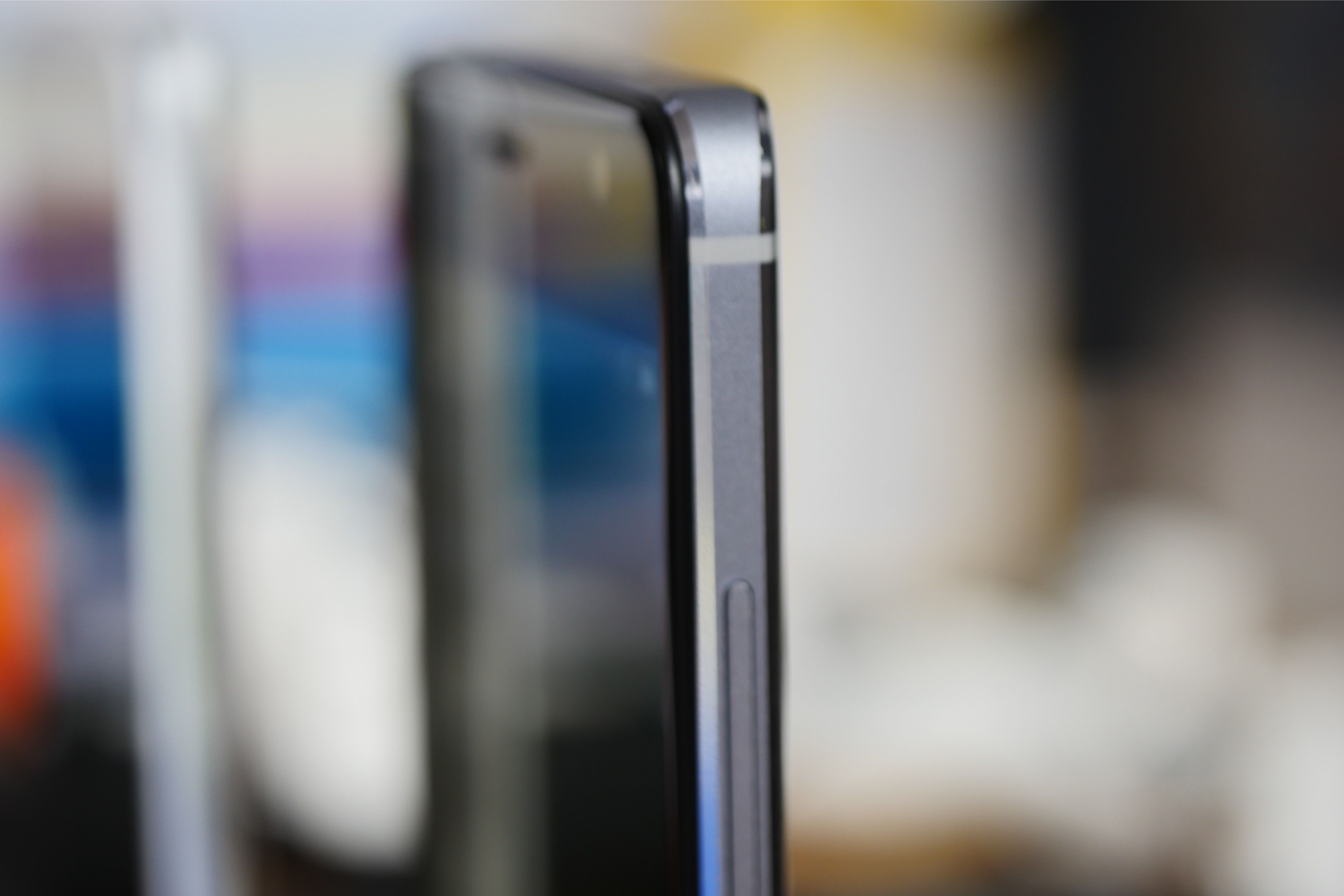
In the frame, the Huawei P9 uses a similar drawing process to that of the back. This allows the P9's metal back cover to maintain a high degree of consistency in both hand and look. From the process point of view, on the P9 border This wire drawing process is extremely difficult, and this is where P9 is the most difficult process. In contrast, the red rice Pro's metal frame is directly "bare" sandblasting.
Due to the processing and processing gaps in the transitional parts of these two phones, coupled with the 8.15mm thick body and 174g “weight†of the Red Rice Pro, although the two phones look somewhat similar at first glance, But feel in your hand
Not a grade at all.
Of course, due to cost and technical reasons, the process and feel of Red Rice Pro are not as bad as those of Huawei P9. After all, the latter's price is to buy two Red Rice Pros, but we think that Under certain conditions, Xiaomi is fully capable of making Red Rice Pro feel better.

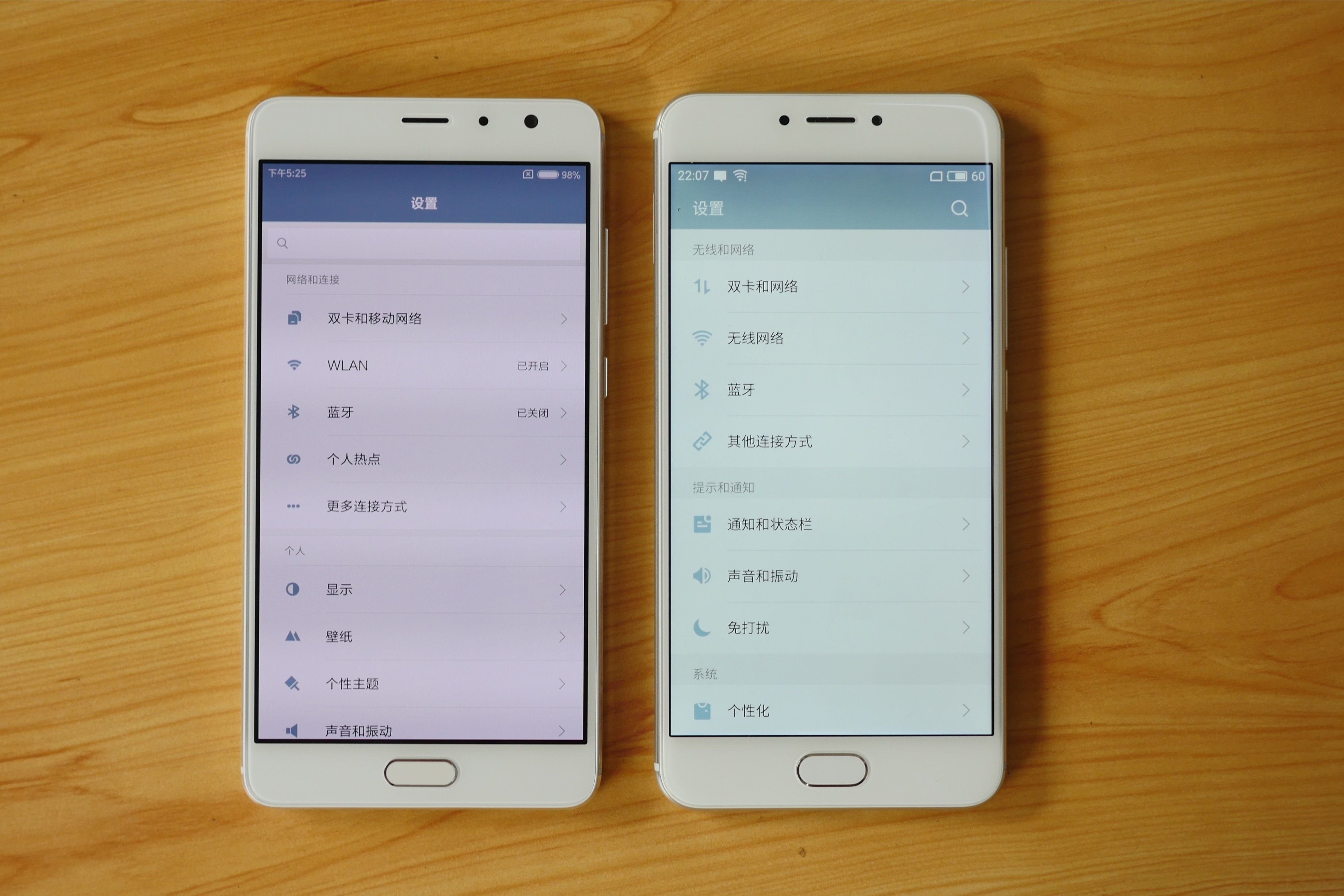
Red Rice Pro and Meizu MX6
Meizu MX6 is a positive example. Through the arc processing of the border part, the smooth transition of the front 2.5D glass, and the appropriately narrowed border, although the absolute technical difficulty, the Meizu MX6 is much lower than the Huawei P9, but The gap that can be experienced with gripping is not that large. Compared to Red Rice Pro, which also has a 5.5-inch screen, the MX6 feels much better.
One word summarizes the appearance of Red Rice Pro : Red Rice Pro is the best red rice mobile phone in history, but it is still a "red rice."
Millet's first OLED, but not AMOLED
Although classified as a low-profile red rice, Red Rice Pro is Xiaomi's first mobile phone with an OLED screen.
The principle and advantages of OLED (Organic Light Emitting Diode) screens will not be described. Interestingly, Xiaomi has used OLED to describe the screen of Red Rice Pro instead of using OPPO, vivo, Meizu, and an official propaganda. Adding AMOELD, which is used by a number of domestic brands, what is this all about?
The reason is that AMOLED is a registered trademark of Samsung Display. Only the Samsung-made OLED screen can be called AMOLED , but due to the use of domestically-made OLED screens from Hefa and BOE, Red Rice Pro can only be called an OLED screen. Here we come Look at the specific display.
The maximum brightness of Red Rice Pro is similar to that of a Samsung AMOLED screen plus one. It is also available in the sun.
However, in the color reproduction, this homemade OLED screen on Red Rice Pro has some problems. The screen of this red rice Pro in our hands is somewhat greenish, and there are some foggy feelings on the white background. The red rice Pro's settings provide three kinds of warm colors, natural and cool colors, but no matter which one you choose, The screen colors are a little different.
This perception reminded me of the AMOELD screen that Samsung provided about a year or two ago (not the one used on its own Galaxy flagship). There is a kind of thick "AMOLED flavor". The recent use of AMOLED screens has basically disappeared. There will be a kind of feeling.
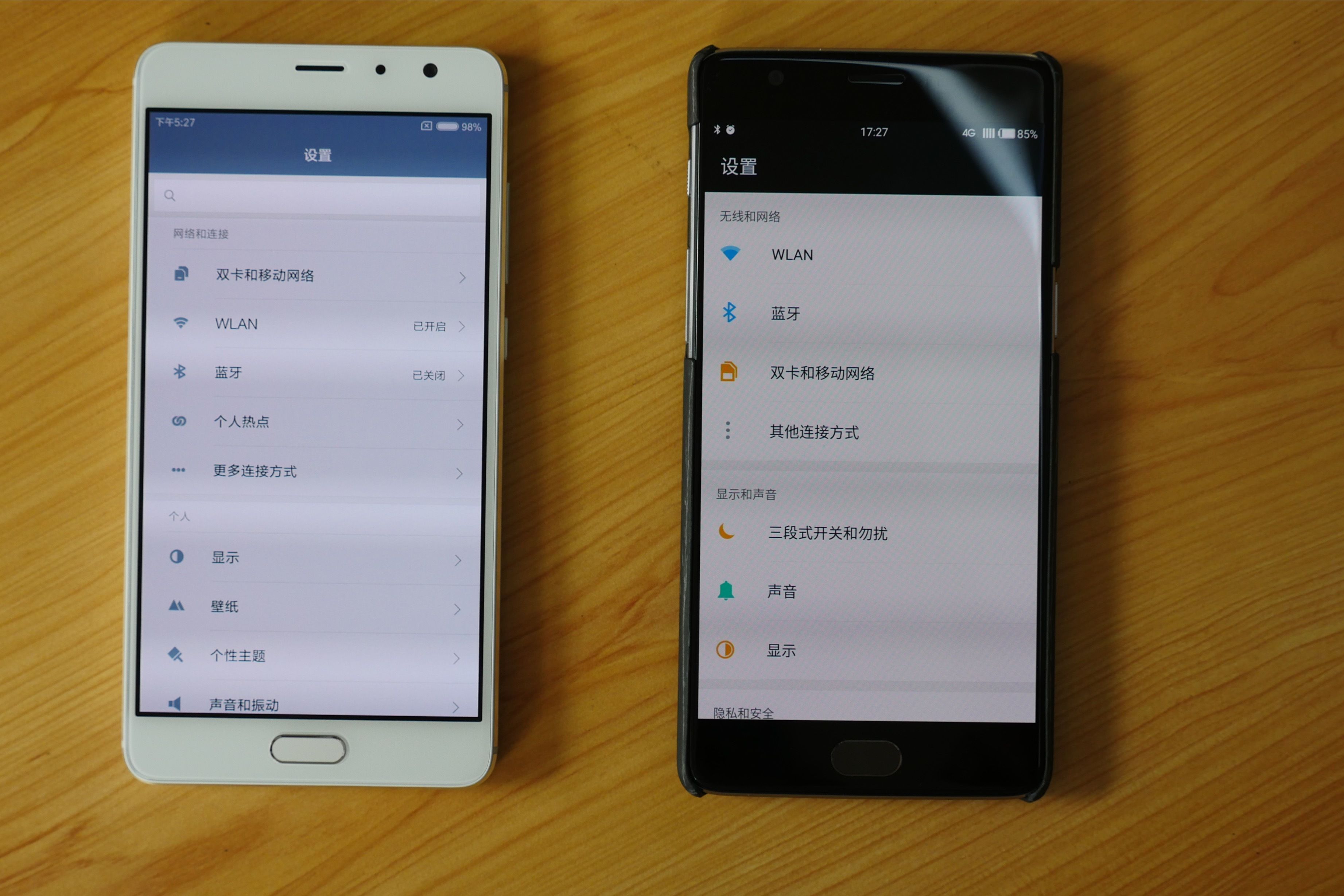
Red Rice Pro and One plus 3

Red Rice Pro and Meizu MX6
The other problem is the refresh rate. We are using the camera to shoot Red Rice Pro, One Plus 3, and Meizu MX6. It can be seen that because the refresh rate is not enough, Redmi Pro can see a clear splash screen. One plus three with AMOLED screen also has a splash screen, but the level is much lower. The Meizu MX6 with LCD screen does not have this problem.
In theory, a low refresh rate will cause the eyes to be more fatigued when reading the screen, but this problem is not easy to quantify. We are also temporarily unable to tell with certainty whether the screen of Red Rice Pro will be more fatigued.
In addition, due to the sub-pixel arrangement problem, putting the eyes on the screen (especially reading text), the Red Rice Pro's screen will have a slight graininess, which is a common problem with the 5.5-inch 1080p resolution. One plus three is used. The same is true for Samsung AMOLED's mobile phones. The personal feeling is that unless you are used to the 2K AMOLED screen on the Samsung Galaxy S / Note, this is not a problem.
Can mobile phones also have "knife sharpening milk"?
In SLR and non-reverse cameras, you can control the aperture size, CMOS size, focal length and other factors to let the photo have a shallow depth of field, so as to obtain the background blur effect.
However, in a mobile phone with a very limited camera module size, it is impossible to achieve a very shallow depth of field in the prior art. As a result, mobile phone manufacturers have come up with another solution - "PS."
Not just to blur the background, I added a camera. With the main camera, we can record the distance of the main body of the picture, and then simulate shallow depth of field and blur out the picture outside the depth of field.
Essentially speaking, this blurring effect is no different from the similar functions of apps such as Mito Xiuxiu, except that with the second camera, it can be automatically processed according to the subject of the shot. This will inevitably lead to the appearance of "virtuality." It shouldn't be a false imaginary situation.
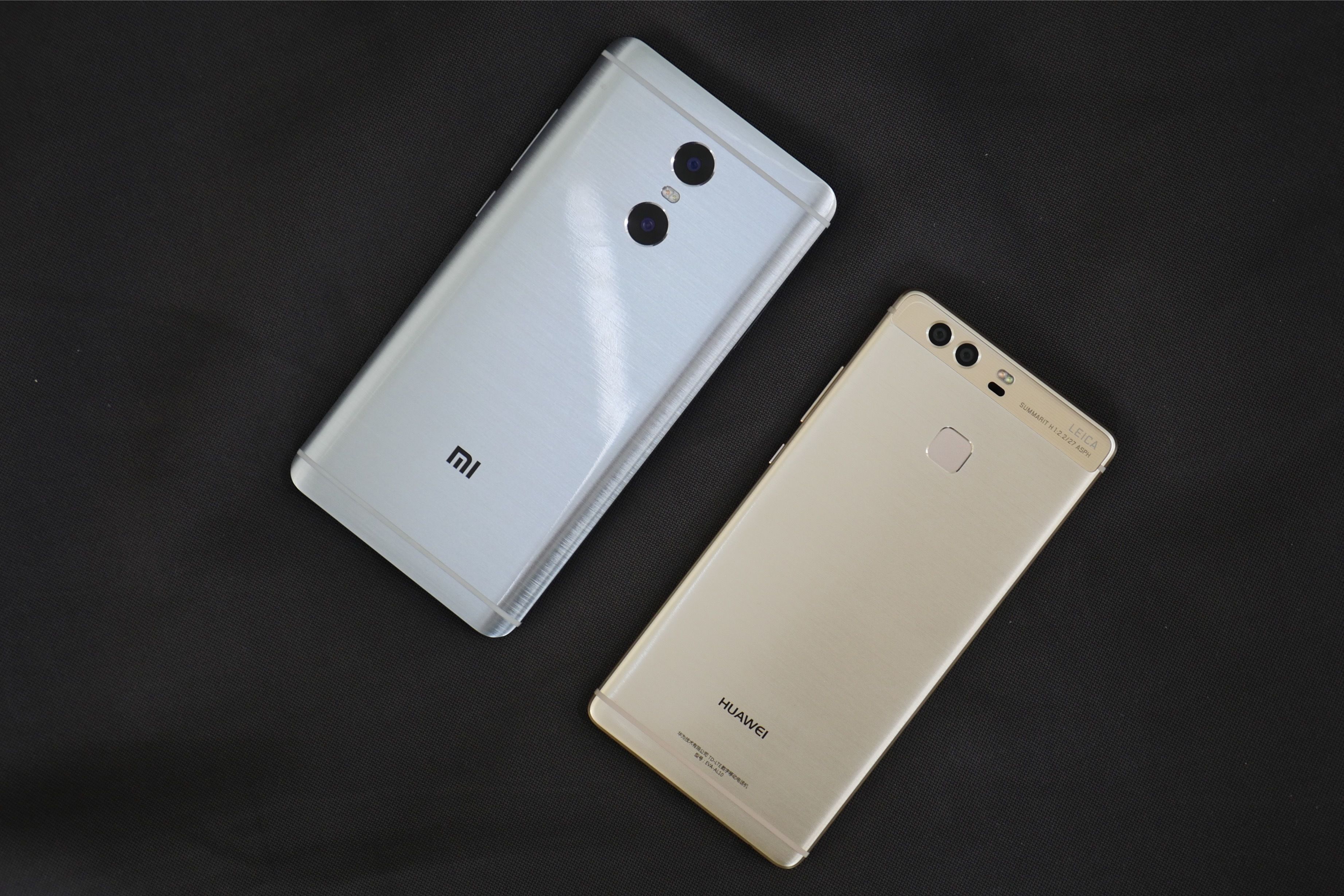
Prior to Red Rice Pro, we already had a dual-camera with dual cameras, such as the Glory 6 Plus, 360 Mobile Geek, Huawei P9, and support for the “big aperture†function. Our geek option (micro-signal: GeekChoice) has also experienced For these three products, the intuitive experience is general and practical.
In order to test the large aperture function of Red Rice Pro, we got Huawei P9 as a comparison.
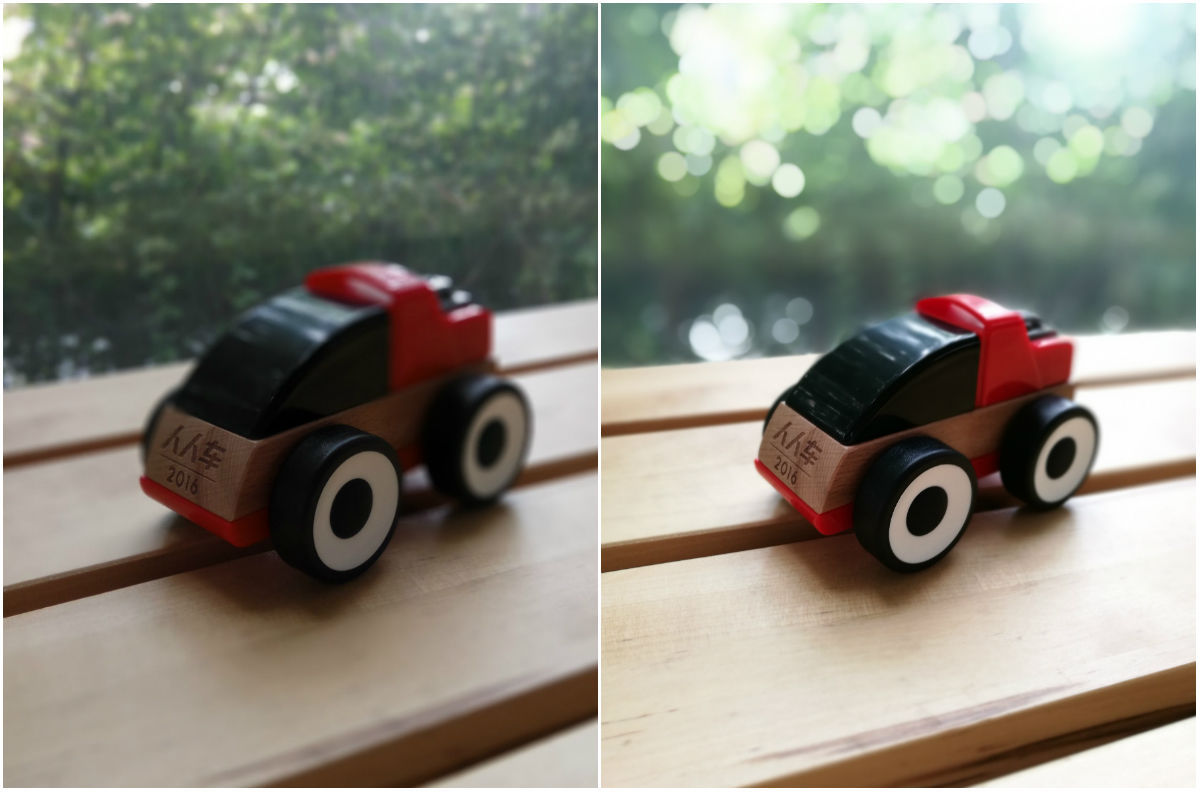
Photographed from left to right by Red Rice Pro and Huawei P9 (f/0.95)
In this set of proofs, we directly set the analog aperture of the two phones to the maximum f/0.95, with the focus on the word "everybody car." It can be seen that the Red Rice Pro has had some "virtuality", and half of the cars have vanished. The edge of Huawei's P9 is not very natural, but it basically retains the outline of the car and is slightly better than Red Rice Pro. .

Photographed from left to right by Red Rice Pro and Huawei P9 (f/4.5)
In the same scenario, the aperture is reduced to f/4.5, and the gap between the two is not so great.
If it is simpler than the so-called "background blurring" effect, Red Rice Pro and Huawei P9 are basically "five steps and sixty steps," and are limited by the hardware level. The blurring of both phones is not natural, and the marginal part can Obviously, the traces from the later period are still far away from the real large aperture on the camera. It is impossible for Xiaomi to publicize the “sharp sharpeningâ€.
In terms of picture perception, Huawei P9 is slightly better than Redmi Pro. The reason is that P9's imaging style is more gorgeous, and Red Rice Pro's color is somewhat dim and the exposure is not quite enough. Plus, P9's “virtual†degree to the background is more. Bigger, let the photo look more likable at first sight. However, we need to emphasize that the advantages of the P9 are only relative, and neither of them can completely replace the real physical big aperture.
Not very photogenic performance
"Large aperture" is finished, we look at the imaging effect of the Red Rice Pro's main camera.
The Red Mi Pro's main camera incorporates Sony's IMX258 sensor, measuring 1/3.06 in., 13 million pixels, with integrated phase focus, and the Red Rice Pro is not equipped with optical image stabilization.
In fact, the IMX258 is not a "fresh" CMOS. The Xiaomi 4c released in the second half of last year was the CMOS. The current transaction price of Xiaomi 4c's Netcom version has fallen below 800 yuan. In addition, some time ago 360. The launch of the two main cost-effective thousand yuan machine N4 and N4S also use the IMX258.
In contrast, we have found three mobile phones, Meizu MX6, One Plus 3, and Huawei P9. During the shooting process, all four phones use the automatic mode, one plus three default does not open HQ (pixel selection). Take this opportunity, we just can also take a look at the current domestic imaging level of two thousand mobile phones.

From left to right by one plus three, Huawei P9, Meizu MX6, Red Rice Pro
In the case of adequate daytime light, the performance of the four mobile phones is not bad and there is no obvious gap between them.
After careful observation, with a high 16 million pixels, the resolution of one plus three is the best, and the remaining three phones perform almost the same. The red rice Pro's picture is slightly colder and its color saturation is lower, which is inconsistent with the current popular "warm color + high saturation" imaging style. At first glance, it is not easy to catch the eyeball. Of course, it is not excluded from Xiaomi. Adjust Red Rice Pro's imaging style in later MIUI updates.
In the daytime photo experience, the performance of the four mobile phones is similar, and there is no problem with the focus metering. The rate of filming is also very high. It is not a big problem to satisfy many people's love to say “hands-onâ€.
There are no major problems during the day. Here we enter the more challenging "Night Shot" session.
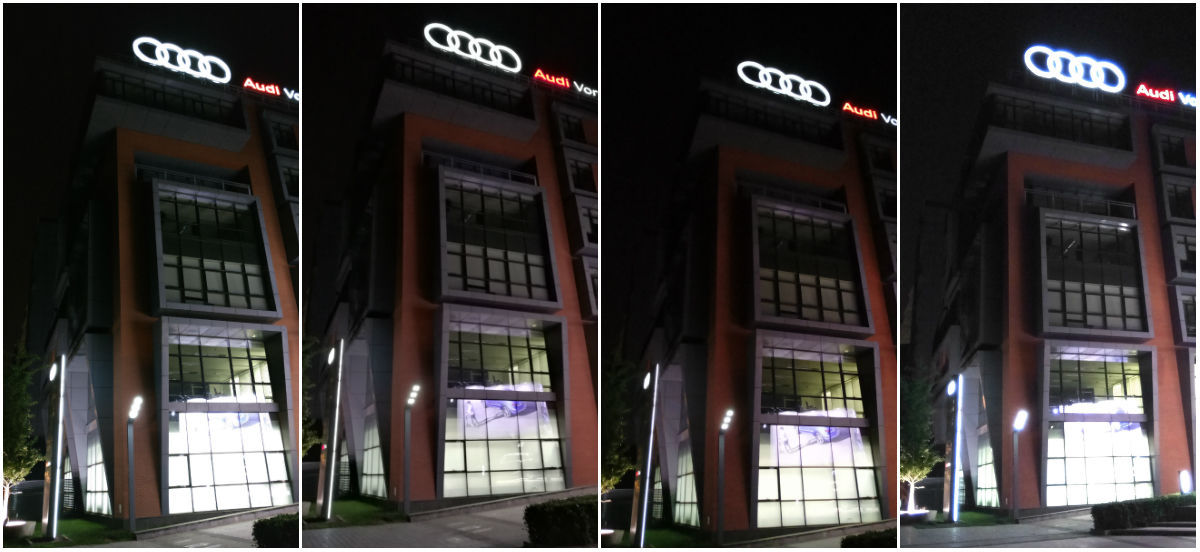
From left to right by one plus three, Huawei P9, Meizu MX6, Red Rice Pro
In this group of night shot Audi China Building, the one-plus-three picture has retained an amazing resolving power. It is the only one of the four mobile phones that can clearly identify the contours of the wall bricks. The other three mobile phones can barely see the noise. Of the remaining three mobile phones, the Huawei P9 performed slightly better than the MX6. The Red Rice Pro's picture was “meat†with the most noise and was the worst among the four phones.

From left to right by one plus three, Huawei P9, Meizu MX6, Red Rice Pro
In the last group of show cars, Redmi Pro automatically enabled HDR, but the noise is still a lot, and the picture is still cold. Huawei P9 and MX6 performed similarly, slightly better than Red Rice Pro. The one-plus-three picture is slightly yellow, but the picture resolution and noise control are significantly better than the other three phones.
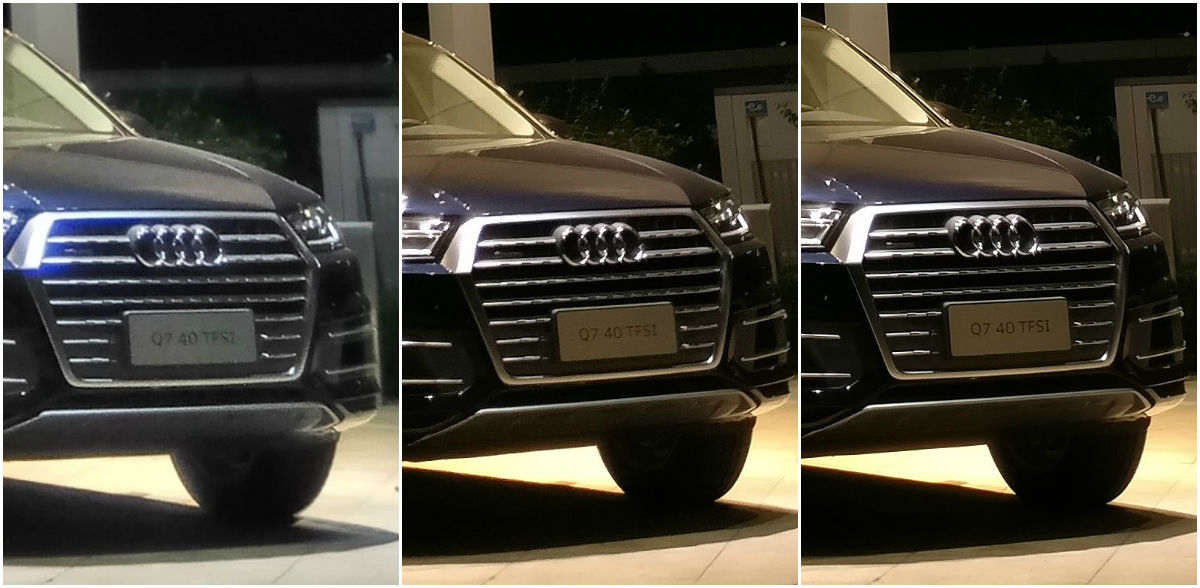
From left to right, shot by Red Rice Pro, one plus three (off HQ), one plus three (open HQ)
It should be noted that this is still taken in one plus three without opening the HQ mode. After the HQ is turned on, there will be further improvements in the quality of one plus three. For example, the license plate number of the show car in the above image will become clearer after the HQ is turned on.
In the photo experience, the performance of the four mobile phones was not perfect at night when the light was not enough. Compared with the daytime, the focusing and filming speed will obviously drop, and there is a certain gap compared to the iPhone 6s. Compared with the Samsung S7 edge, the gap is obvious. In addition, in this case, the red rice Pro's touch focus is not very reliable. Occasionally, it will not be able to focus even after pulling the bellows several times.
In the end, simply summarizing, simply looking at the picture quality, whether it is day or night, the performance of one plus three is very close to Samsung S7 edge this level of product, but there is still a clear gap in the camera experience such as focusing, on the domestic machine One, plus three imaging qualities can hardly find an opponent. The Huawei P9 and Meizu MX6 have used the IMX286 and IMX386 respectively. The two Sony-customized CMOSs ​​have almost exactly the same parameters. The P9 has a black and white camera. The actual imaging effect P9 is slightly better. It is worth mentioning that although The MX6 did not have much surprise in the picture quality, but with a high rate of filming, the MX6's overall camera performance was significantly better than any previous mobile phone in Meizu.
As for the Red Rice Pro, some "antique" IMX258s are unable to fight Sony's new generation of CMOS such as the IMX298/286/386. The less eye-catching imaging style further widens the gap. However, this is basically in line with Red Rice Pro's product positioning: it is better than most thousand Yuan machines and worse than the "China Flagship".
Performance, battery life and some minor details
Red Rice Pro's SoC is MediaTek's Helio X20 or X25. In short, unless you often use mobile phones like the NBA 2K16, which is a big test game for GPUs, the Helio X20 / X25 used on Redmi Pro will not be a bottleneck in experience. Of course, it is not ruled out that due to optimization problems, some popular mobile games occasionally get stuck.
The Red Rice Pro is equipped with a 4050 mAh battery. Since the Helio X20 / X25 consumes significantly more power than the previous Helio P10, the actual battery life is roughly equivalent to the 3300 mAh Helio P10 phone. Actually, the red rice Pro's battery is more durable than the one plus 3, Meizu MX6 and other 3000 mAh battery mobile phones, more than a day more than enough.
However, the Red Rice Pro does not support fast charging. Fortunately, using the original 5V, 2A head charging is not too slow. In the off state, the measured charge can be 32% for half an hour, 62% for one hour, 86% for 90 minutes, and approximately two hours for full charge.
In addition, Red Rice Pro has two small details worth noting.
Red Rice Pro supports infrared, and can be used as a remote control in case of emergencies, but it is regrettable that Red Rice Pro does not support NFC.
Like Xiaomi 5, the fingerprint identification button on the front of Red Rice Pro is also on the front, and can be set to touch back to the homepage in the settings, but it cannot be set to touch return like Meizu and ZUK.
It is not millet's OPPO R9
Finally, we talk about the pricing of Red Rice Pro.
Red Rice Pro is available in 3 versions. The standard version is configured with Heliio X20 + 3GB + 32GB storage for $1499. The high version is configured with Helio X25 + 3GB + 64GB storage. The price is 1699. Yuan, enjoy version is configured as "Helio X25 + 4GB storage + 128GB storage", priced at 1999 yuan.
Selling red rice and low-priced millet 5 at a price, which exceeds many people's expectations, and incurred a lot of users Tucao. Even if compared with OPPO, vivo and other brands, the price of Red Rice Pro is still very low, but who calls it the red rice, who called 360 N4S such "no life" product?
Red Rice Pro is so priced, offline channel is an important reason. In order to sell online, Xiaomi would have to leave hundreds of dollars in profit for the channel. At the same time, in order to sell offline channels, the price on the line cannot be higher than offline, which leads to less “red riceâ€. The pricing.
This practice of Xiaomi actually bears great risks. If the offline channel does not sell fire, the inventory of the original offline channel warehouse is likely to be transferred to an online platform such as Taobao at a low price. As a result, online services such as the Xiaomi Mall cannot be sold, and the result is no breakthrough under the line. It also affected online sales. Therefore, the success of Red Rice Pro is largely determined by whether it is sold online or offline.
This is precisely the problem with Red Rice Pro: It is not a product for the offline.

In areas where consumers, such as design, workmanship, screens, and photographs, are most likely to perceive, the Red Rice Pro is still very “red rice,†and lacks the refinement and quality that “line explosions†should have. Red Rice Pro also lacks a clear selling point. In the case that everyone's products are doing well, a simple, clear and impressed customer's selling point may directly translate into sales, such as the fast charge and fingerprint of OPPO R9. , Vivio X7's self-timer, and even Meizu MX6's design. What is the selling point of Red Rice Pro? Most customers do not understand the 10 core? Or is it a double-jing head with "extrusion"?
Compared with the above products under the same main line, Red Rice Pro's biggest advantage is the configuration and price. In this era of hardware surplus, configuration is precisely where offline consumers are least likely to perceive. As for the selling price, considering that the Xiaomi brand's presence under the line has been very low, it is not easy to say how many users can pull the price of the Xiaomi brand, which is lower than the “OV†by a few hundred yuan, when the product is not “rightâ€. .
From the product point of view, Red Rice Pro is still a product full of “Internet thinking†and built for Xiaomi’s traditional online channels. If we can maintain the original red rice pricing strategy, Red Rice Pro is expected to become another product. The "thousands of explosions" on the line, but the trouble is that Xiaomi prefer to make it into their own OPPO R9 and vivio X7.
At present, this task is somewhat arduous.
live steaming social media apps like facebook,youtube,tiktok,android and iPhone wired wireless projection,LAN and wifi internet access,HDMI interface.live streaming becomes more and more popular with young people these days,with a global covid-19 comes,more and more people started to live broadcast in their home and office,for advertising their products,fans interaction as a internet celebrity,online performance,a live show,but it is not so convenient with their mobile phones,the screen is too small so that they can not see clearly,our big size screen solved this problem,by using wired and wireless mobile projection function,and other necessary tools,like camera,microphone,the lighting,a live streaming can be more efficiently and with more fun.and we design a movable bracket,you can move it to anywhere you like,to satisfy different necessities for different locations.
Wired Projection Scree,Live Streaming Big Screen,Lcd Touch Screen Monitors,Lcd Touch Screen Equipments
Jumei Video(Shenzhen)Co.,Ltd , https://www.jmsxdisplay.com
![<?echo $_SERVER['SERVER_NAME'];?>](/template/twentyseventeen/skin/images/header.jpg)